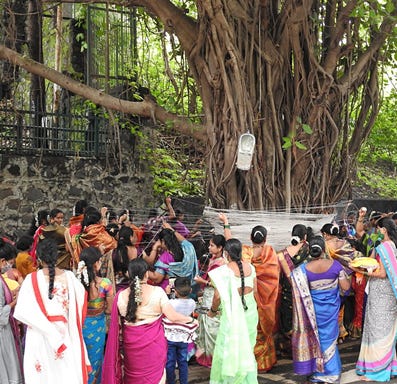Planet Ficus Monthly Roundup #1
Lizards as seed dispersers. An 'assassinated' banyan. Rituals of Kenyan elders. Singaporean stamps. Hindu women's prayers. Award-winning authors. A new fig species. Landmark public art.
Welcome to the First Planet Ficus Monthly Roundup
Each month, I’ll bring you stories from around the world that reveal just how extraordinary fig trees are — not just biologically, but culturally, spiritually and artistically.
When I started Planet Ficus, I already considered fig trees to be the most fascinating plants on Earth. But even I was astonished by the sheer breadth and depth of stories I came across just last month.
In this first roundup alone, you’ll find new scientific discoveries about fig trees and animals that eat them, sacred rituals performed beneath their branches, fig tree appearances in literature and visual art, conservation efforts involving these ecological keystones, and much more.
This variety is not random — it’s evidence that fig trees are everywhere in the human story and central to many ecosystems and cultures.
My mission with these roundups is simple: To show you that fig trees are the most interesting, important and awe-inspiring plants on the planet.
Thanks for joining me on this journey. I hope these stories surprise and delight you, and maybe even change the way you see the natural world.
Let’s dive in.
Biodiversity, Ecology and Conservation
Scientists working in Laos have identified a new fig species, which they have named Ficus flavifolia. Unlike typical trees or the famous strangler figs, this species is a climber. The name flavifolia refers to the yellowish tinge to the underside of the plant’s leaves. The total number of fig species is now approaching 900!
Lizards are likely to be seed dispersers of fig trees in Madagascar, according to new research. Scientists reported that the western girdled lizard (Zonosaurus laticaudatus) eats wild figs and that the seeds survive passage through the guts of these reptiles. They join the ranks of more than 1,300 fig-eating animal species.

In Malaysian Borneo, conservationists have removed more than 1,000 fig trees that were growing on buildings in the city of Kota Kinabalu, Sabah. The fig trees will be replanted in reforestation sites to serve as a food source for wildlife and attract the seed dispersers of forest trees.
Singapore included a painting of strangler fig called Ficus stricta in a new set of stamps issued to highlight endangered plant species.
Religion, Faith and Myth
In Kenya, Charles Mgenyi reported that Kaya elders performed a cleansing ritual at a centuries-old fig tree at one of their most important spiritual sites, a shrine that is set to be lost for the development of a major dam.
Fig trees are also sacred to Kenya’s Kikuyu people. On 26 May, a branch from a mugumo fig tree (Ficus thonningii) fell onto some shops in Nyahururu town, Laikipia County. In response, Kikuyu elders were called to assess the situation. According to Kikuyu lore, the complete fall of a mugumo tree is seen as an omen — often signaling major change. In this case, however, the elders concluded that the branch had simply fallen due to the tree’s age.
On 11 May, in Myanmar, Buddhists celebrated the birth of the Buddha by pouring scented water on sacred fig trees of a species called Ficus religiosa. It was beneath a tree of this species that the Buddha is said to have attained enlightenment.
On 26 May, married Hindu women in India and Nepal observed Vat Savitri Vrat, an annual ceremony in which they tie threads around banyan trees (Ficus benghalensis) and pray for their husbands’ health and longevity. The ritual is named after a story more than 2,500 years old, about a woman named Savitri, whose husband died beneath a banyan tree. According to the legend, Savitri’s unwavering devotion moved Yama, the God of Death, to bring her husband back to life.

In Bangladesh, a two-century-old banyan fig tree was cut down in a controversial act driven by religious and ideological motives, sparking debates on cultural erasure, environmental destruction and governance failure. Writing in Bangladesh’s Daily Star, Zakir Kibria said: “This was no mere deforestation. It was an assassination—a calculated silencing of memory, faith, and ecology.”
Useful Fig Trees
What’s more useful than an edible fig? Delish magazine republished an article in which I am quoted: Are Figs Vegan? The Surprising Truth About Wasps In This Fruit.
The state government of Meghalaya in India held a workshop on its iconic living bridges made with the roots of fig trees (Ficus elastica) as part of its efforts to have the UN Educational, Scientific and Cultural Organization (UNESCO) register the bridges as World Heritage sites — see my story on the bridges.
The aerial roots of strangler figs have inspired chemical engineers in China to design a structure with practical applications in atmospheric water harvesting, plant irrigation and power generation.
Art and Literature
On 22 May, Banu Mushtaq won the International Booker Prize for her short story collection Heart Lamp. Reflecting on her win in an interview with the Times of India, she referred to the fig trees called banyans (Ficus benghalensis) found in many Indian village: “A story born under a banyan tree in my village can cast its shadow across the world.”
On 25 May, novelist Elif Shafak — whose books include The Island of Missing Trees which features a fig tree as a narrator — won a Hay Festival Medal for Prose. Find her on Substack here.
A giant non-native fig tree in Culver City, California is going to be incorporated into a public artwork by conceptual artist Charles Gaines. In a work called A Frame For A Tree, he will install a large metal frame — 98 feet wide and 56 feet tall — behind the tree. Gaines says: “By framing this tree within a precise structure, I hope the viewer will consider the context of this natural space and leave with new insight.” The installation will take place in 2026.
Awesome Fig Trees
Contestants in the Miss World 2025 competition visited one of the largest trees in Asia — a huge banyan fig (Ficus benghalensis) near Mahabubnagar City in Telangana, India. The tree is thought to be 700 years old and its crown covers four acres (1.6 hectares). Over time, the tree’s branches have sent down aerial roots that have thickened into stout pillars, enabling the branches to continue growing. These roots are as thick as tree trunks, making the banyan appear to be a small forest of hundreds of trees, not just one individual.
Over To You
Do you have a memory, photo, or observation involving fig trees? I’d love to hear from you. Send your story or image to planetficus@substack.com — I’ll feature selected entries in future editions. Thanks for reading!






